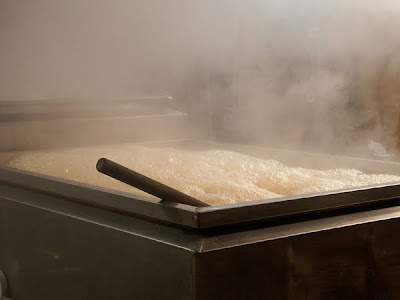
This afternoon I went down to the Sugar Shack here in Arlington to photograph the process of turning maple sap into maple syrup. I just wish there was a way to upload aromas to the internet, as it's impossible to truly have the full experience when you don't get that blast of sweet-smelling warm air when you first walk in.
Sap being poured into the main evaporator:

A look at the entire evaporator, first from one side:

And then the other; in this one you can see the white pipe that feeds the collected sap that's stored outside into the system:

The amount of wood they go through is insane, although not surprising considering they're looking to keep the temperature at more than 1000 degrees underneath the sap:

The top half of the evaporator, where about 90 percent of the sap's water content is boiled off:

And the bottom half. As the sap in the upper half boils and starts thickening, it sinks below the sap that's still mostly water. It then flows through a small pipe into the lower half. As it continues to get denser and heavier, it wends its way through these four sections (in this view, from left to right) as if it's in the line for Disneyworld—and just about as slowly too:

Finally, the sap arrives in this box on the side. The temperature gauge indicates how many degrees above the boiling point of water the sap has reached—the number they're looking to hit is 7:

A shot of the syrup beginning to collect in the bottom:

They don't simply rely on the temperature reading to tell them when the sap has become syrup. Instead they scoop up some of it in the flask that's now hanging in the box and test its density with the hydrometer that's just behind it—I presume it's kept there so it stays warm enough that it won't shatter when put into the hot liquid:

Another look at the sap boiling in the lower half of the evaporator, along with a scoop they use for a variety of tasks:

One of the guys in charge of the boil also used a more traditional method of checking to see if the syrup is ready to draw (ie be drained into a receptacle); he dips his scoop into the liquid and watches how it drips off the edge. When it looks like a hanging curtain, you know you're pretty much good to go:

At this stage of boiling, we weren't too far from the first draw:

And finally, success. It took about two hours from the time I arrived, as they'd just started boiling, to get to this point:


The final step—pouring the syrup through several layers of cheesecloth to remove any impurities. They then used the spigot at the bottom to fill their bottles for resale. Today's syrup ended up being grade B, which is mainly used in cooking because of its intense flavor.

Finally, because it cracked me up, a little something put together by the men who do the sugaring for one of their friends; apparently Smedley occasionally has trouble getting himself in gear when his help is needed:

The syrup process is fascinating, Sara, thank you for documenting it!
ReplyDeleteThe mouse is very cute, at least in its native habitat. In my patio, probably not so much.
Mmmmmmmmmm. Now I want some pancakes. :-D
ReplyDeleteVery cool. Cute little mouse!
What a terrific photo essay. It's much more thorough and the photos are more interesting than most books on sugaring. It would make a great pamphlet.
ReplyDelete